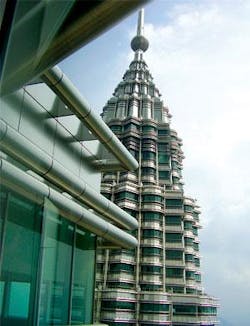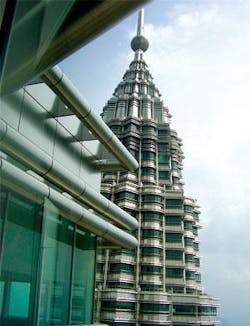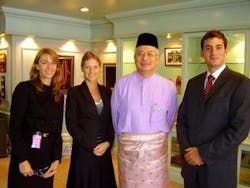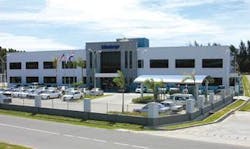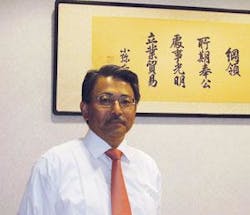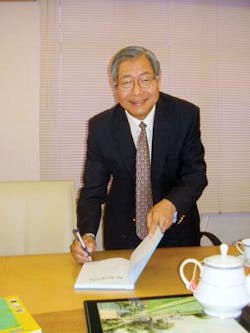Special Report: Malaysia
E&P expenditures spur growth in Malaysia
Since its founding as an independent nation in 1957, Malaysia has benefited from institutional wisdom, which has been at the heart of the country’s remarkable economic development.
Dato’ Sri Mohd. Najib Tun Abdul Razak, deputy prime minister of Malaysia, points out that this keen judgement is evident in the decision to negotiate independence rather than fight a horrific war against the British colonial occupiers in the decade after World War II.
“This position preserved our institutions from our first days as an independent country and led to a very peaceful and methodical transfer of power from the old British (colonial government),” said Najib.
The Malaysian energy industry is on a roll - establishing a presence in many of the most promising global energy markets. Petronas, Malaysia’s national oil company (NOC), is already one of the top oil and gas giants in the Fortune Global 500. In the year ending March 31, 2005, the company posted over US$15 billion in revenues, almost US$8 billion in profit before tax (PBT), and over US$34 billion in asset value, with a network in place to grow larger still.
At home, Petronas has played an important role in the development of the industry. Najib states, “Petronas has taken a successful leadership role in developing local expertise to the point where the Malaysian oil and gas services industry relies much less on foreign expertise and is positioned properly to venture abroad.”
Many local service companies, formed within the last two decades, have rapidly developed the essential competencies to serve Petronas, and other international oil companies active in Malaysia.
In 2004, Malaysia produced more than 617.1 million of barrels of crude oil and natural gas from 75 different fields - half of which are operated by Petronas Carigali, Petronas’ E&P arm. E&P expenditures are at their highest point and domestic production is growing steadily. E&P reached 1.2 MMboe/day in 2005 (1 million in 2002). The number of production-sharing contracts (PSCs) within Malaysia reached a record 53 in 2005.
While natural gas reserves, which still constitute 73% of the country’s total reserves, have declined marginally to 85.20 tscf, the level of Malaysia’s total reserves has been maintained. The reserves have held steady at 19.49 boe as of January 2005. Thanks to aggressive exploration activity by Petronas and its partners, the country holds an average of 19 years of crude oil and 33 years of natural gas reserves at the current rate of production.
Clearly, if Malaysia is to maintain its status as a net hydrocarbon exporter and a subsidized energy provider at home, it not only must consider deepwater E&P opportunities, but also put added emphasis on enhanced oil recovery efforts in mature assets, as well as the development of small fields.
This new trend is generating valuable economic activity for the country’s oil and gas support industries and attracting a new profile of oil and gas companies. With booming activity, more international companies are choosing Malaysia as their regional hub.
Over the years, Petronas has long balanced its domestic investment portfolio with aggressive growth abroad. To that end, company management has spent the last decade methodically and organically expanding both upstream and downstream operations into 35 overseas markets. Tun Dr. Mahathir, former prime minister of Malaysia and advisor to Petronas, asserts that “Petronas is one of the few NOCs that have successfully become a multinational company with an overseas portfolio.” He adds, “Petronas is getting popular as an alternative to other multinationals.”
Malaysian engineers and workers are also in demand. Because of their experience, these workers are being recruited for positions around the world, especially in the Middle East. This creates new challenges at home - a lack of human resources and rising salaries.✹
Petronas: NOC or IOC?
It wouldn’t hurt for managers of national oil companies (NOCs) to look at Petronas’ development strategy. The success of the company is such that it could redefine the threshold between NOCs and IOCs.
Year after year, the management of the Malaysian national oil company, which has vested ownership and control of the domestic petroleum resources, has managed to play the role of national hydrocarbon industry promoter while becoming an aggressive and competitive commercial entity - an entity that stretches from Southeast Asia to Africa.
For Tan Sri Hassan Marican, president and CEO of Petronas, the spirit which led to the creation of Petronas explains this success. “We were established as a commercial entity that had to develop and chart its own course even in Malaysia,” he says. Petronas has grown to become a Fortune Global 500 corporation by becoming what Marican calls “a global company that happens to have its address in Malaysia.”
In fact, unlike most NOCs, Petronas has grown far beyond its boundaries. Today 80% of Petronas’ revenues are generated outside of Malaysia and 30% of its petroleum reserves are located overseas. According to Marican, “Foreign production should exceed the national one within two or three years.”
Besides Southeast Asia, where Petronas collaborates with NOCs in Vietnam, Thailand, Indonesia, and Myanmar, Africa has always been one of Petronas’ focuses for E&P. In North Africa, the company has developed a good understanding of the local geology of a region Marican dubs “the next hotspot for the industry.” Marican recently announced that Petronas will establish its African regional headquarters in Sudan, where the company runs its largest foreign operation with 500 employees.
Petronas is a sought-after partner in downstream activities as well as the E&P sector. In South Africa, for example, it owns 100% of Engen, the nation’s leading (28% market share) domestic network of retail gas stations. Petronas also invested in a product refinery in that country and recently announced a joint venture for a 150,000 bpd refinery in Sudan.
Petrochemicals represent 10% of the company’s business. According to Marican, the main focus will be ethylene and propylene based products. “Our strategy is to form joint ventures with the major petrochemical companies such as Dow Chemical and BASF,” he adds.
But LNG is what really differentiates Petronas. It chose to invest in the sector 20 years ago, long before it became the flavor of the month. In Malaysia, the Bintulu gas complex is “the single largest and maybe most impressive LNG complex in the world,” recalls Marican, who also predicts that LNG could become the company’s second largest source of income in the years to come.
Although Japan and Korea are Petronas’ biggest LNG customers, Europe and the United States are part of the company’s global LNG strategy. Petronas holds a 25-year LNG supply contract that followed a joint-venture in Egypt with British Gas, with whom they have also partnered to build a re-gasification terminal in the United Kingdom.
The company’s international positioning is greatly enhanced by the ownership of MISC, the world’s largest LNG tanker owner and operator, and second largest Aframax vessel owner and operator.✹
Deepwater and EOR create new opportunities
Today the Malaysian E&P sector is faced with an interesting combination of two main challenges: developing deepwater petroleum assets and improving recovery factors, especially for marginal and smaller fields.
Abdullah Karim, Petronas’ vice president of E&P, assesses the potential of deep water for Malaysia:
“Recent discoveries clearly support the claim that the virgin waters off the coast of Sabah have very strong potential for reserves. So far the results are very optimistic - a 100% success rate in Sabah deep water exploration wells. While shallow water fields here may yield 30 Mbpd, deepwater finds are likely to produce 500 Mbpd,” he says.
Karim acknowledges that such developments are dramatically limited by the availability of rigs. In any case, this is also redefining the face of the Malaysian E&P sector because traditional partners of Petronas in production sharing contracts (PSCs) are reluctant to take on the new challenges posed by marginal fields. This has forced Petronas to find new partners willing to participate in enhanced oil recovery (EOR) operations.
Nevertheless, Karim hopes that the recent discoveries will lead to the creation of a deepwater service hub in Malaysia. “Our ultimate goal is for major operators like Shell to set up a full-capability center here that is similar to what they have in Houston. Petronas certainly has the will and the capacity to serve as the primary catalyst building regional deepwater hub capabilities on all levels,” he says.
Stephen Kaufmann, the Trinidadian vice president and general manager of Schlumberger Oilfield Services in Malaysia, Brunei, and the Philippines, agrees with this analysis. “Petronas is in a prime position to spur Malaysia’s further evolution into a regional deepwater service hub,” says Kaufmann. In fact, last year Schlumberger completed a US $5 million Deep Water Centre of Excellence in Labuan.
Kaufmann notes that while in the past most focus was given to the North Sea or the Gulf of Mexico, today the trend is changing as E&P activities are gradually “shifting to the East” and that service companies are following the trend and paying increasing attention to the region. In Malaysia, Schlumberger already applies all the latest technologies it has developed worldwide. In fact, because of the challenging environment, the region poses opportunities for the development and deployment of new technologies, and the uptake of new technology in Malaysia has been fast and progressive.
Not only are the latest technologies and corporate global standards applied in a country that Kaufmann dubs a “sleeping giant,” but the company is also developing new technical solutions to cater to regional environments and deliver adapted solutions to Petronas, which has become a major customer for Schlumberger.
For example, Schlumberger teamed up with Murphy Oil in the Kikeh field to develop a technical solution to improve the accuracy of measures taken through gas clouds. Shallow gas clouds, which challenge the use of traditional seismic technology, prevail in the region. This solution was awarded with one of three gold medals for innovation through the “Performed by Schlumberger” internal recognition program.
For Kaufmann, an important aspect of Schlumberger’s success in Malaysia is the company’s willingness to enter into partnerships where it shares both risks and rewards. Encouraging new companies with new approaches is paramount in Petronas’ search for partnerships to rejuvenate mature assets or capitalize on marginal fields.
Petrofac, a company recently listed on the London Stock Exchange, entered Malaysia in late June 2004 by purchasing the 30% operating stake in the Block PM304 of the Cendor field from Amerada Hess.
Richard Hall, vice president of operations and development for Petrofac Resources worldwide and general manager at Petrofac Malaysia, explains the company’s strategy for Cendor.
“Our different approach, fine tuned in the North Sea, focuses on incremental production with careful risk mitigation rather than large-scale investment,” said Hall.
Cendor is not marginal due to volume of oil in place, he said, but rather because of uncertainties in reservoir connectivity and productivity. Hence for Petrofac, the key to development was a low-cost, flexible, and phased approach. This is why they chose to introduce the Mobile Offshore Production Unit (MOPU) concept to Malaysia. Its design consists of an unusually long span of unsupported conductors, and will utilize a low-cost submerged flexible composite pipeline to the FSO.
“This approach enables us to deal with a number of reservoir uncertainties in a highly cost-effective manner and gives us the flexibility that wasn’t previously conceived,” Hall added.
He believes the initial key oil rate at PM304 will approach 12,000 bpd and that the field life of this first phase should be 8 to10 years. He hopes that if additional wells show added reserves, they will already have the capacity to produce up to 25,000 bpd. Considering the critical mass of the Cendor development, Kuala Lumpur, Malaysia’s capital and largest city, was chosen as Petrofac’s development hub for a region where, according to Hall, they have “every intention of developing a more significant presence over the medium term, both through the further development phases of PM304, new partnerships with Carigali and other active E & P companies,” but also through ventures in Indonesia.
Rozali Ahmad, managing director of RNZ Integrated, a Malaysian engineering and design company, also foresees growing opportunities for a new kind of company in Malaysia. He states, “There is no shortage of promising marginal and deepwater field development that will arise in Malaysia over the course of the next several years. Petronas Carigali is just starting to show interest in pursuing the necessary cost-efficient solutions for small field development. This creates opportunities for companies like Talisman, Murphy Oil, Petrofac, and Newfield Exploration that seek out third-party verification and approval of the safety of their bare-bones platforms before commissioning them in marginal field development.”
Ahmad hopes that RNZ Integrated, the company he founded 12 years ago with the wish to become one of Malaysia’s main design consultants, will be able to reap the benefits of such developments thanks to the alliance developed with Mustang Engineering, a Texas-based company specializing in deepwater platform design.
RNZ is the only Malaysian company to have received one of the six sought-after licenses delivered by Petronas to Umbrella design companies. It has to compete against international brands such as Technip, Kvaerner, Ranhill, and others.
According to Ahmad, the company, whose main focus is on upstream activities, is currently undergoing a positive phase of development and has tripled its number of employees over the last two years. In the coming years, he foresees income growing steadily by 30% to 40% annually, as well as a listing on the Kuala Lumpur Stock Exchange.✹
Mitsubishi has stake in Malaysian LNG
Japan is one of the main importers of Malaysian LNG, so it is no surprise that the Mitsubishi Group has been involved in Malaysia’s LNG sector since its inception. Nowadays, through its trading branch, Mitsubishi Corp., the group holds stake in all three phases of LNG production at Bintulu, which produces 23 million tons annually and delivers 20% of Japan’s total imports.
Originally, Mitsubishi teamed up with Shell and Petronas in 1978 for phase one of this forward-seeing project. Tetsuro Kuwabara, senior vice president of Mitsubishi Corp. and CEO in Malaysia, who has been working in Malaysia since the late ‘70s, recalls that in the past, input was limited to financing and marketing. But things are changing. He explains, “We see our function as an LNG marketer lessening year after year as the sector is becoming less difficult and more commonplace. On top of this, Petronas has such strong corporate strength that our financing capability does not count so much anymore, so we need something more material.”
By “something more material,” Kuwabara means getting involved in upstream not only through financing partnerships, but also by becoming an operator. Mitsubishi Corp. is currently a minority partner in gas producing fields with Shell and Nippon Oil Corp. and has spent US$40 million in exploration projects with Shell, Exxon, and Repsol.
“It is now time to take the lead rather than just tagging along,” declares Kuwabara who adds, “Since we had not maximized opportunities to move up the value chain and become a more integrated organization in Malaysia, we have recently changed our growth strategy to focus on the acquisition and development of fields as an operator rather than as a marginal shareholder.”
According to Kuwabara, Mitsubishi not only intends to get involved in gas fields to feed Bintulu’s huge capacity, but also in operating oil fields.
“We now want to increase reserve assets, especially of oil, and also increase our capabilities to operate oil fields,” he explains. “We are taking actions to acquire small and medium sized acreage as an operator with the goal of generating cash that will allow us to subsequently pursue the operatorship of gas fields.”
With Petronas’ declared interest to partner with smaller E&Ps to develop more than 80 identified marginal fields relinquished by big players, Kuwabara hopes the timing is ideal. Getting involved with small fields may sound backward for a group with the financial capability of Mitsubishi, but Kuwabara justifies this modest approach referring to an old Chinese proverb: “Better to be the leader of chickens than the follower of cows.”
As an aspiring “leader of chickens,” he believes that Mitsubishi can use its basic competence in management and technology to operate smaller fields “before becoming an upstream player in a broader sense.”✹
O&G has major role in Malaysian economy
“Really, O&G is now the darling of the Malaysian economy,” says Ahmad Zakie Ahmad Shariff, group CEO of Orogenic Holdings. Financiers of all forms are now putting O&G as priority investment sector.” Orogenic, a geology and geoservices company, has directly benefited from exceptionally high E&P domestic expenditures that have gone way beyond expectations, explains Zakie.
After multiple successful geological and geophysical (G&G) contracts and mudlogging services with Petronas Carigali, Murphy Oil, Esso, ExxonMobil, Amerada Hess, and new players to Malaysia like Newfield and Petrofac, Zakie glows. The company has directly benefited from these recent developments. He explains, “The trickle down effect has been kind to us and we do not expect investment levels to be reduced any time soon.”
The next step for Orogenic is to follow Petronas throughout Southeast Asia, where they are already active and into the Caspian region, the Middle East, and Africa. “We hope our home-grown Malaysian expertise and innovative adaptation of high technology will make us a natural partner for PETRONAS internationally,” says Zakie. But for the moment, the company focuses on catering to local demand.
Zakie explains that while Orogenic’s goal is to take on more international projects, and while they have already received inquiries from African and regional oil companies, “The local order book is so strong that Orogenic is coping with a short-term bottleneck of human and equipment resources.”
Orogenic is the single largest local G&G employer in Malaysia with 60 total geologists, most of whom are Malaysian. With most local companies involved in supply-side activities, there are very few Malaysian companies active in G&G. Hence, Orogenic has been forced from the beginning to use international benchmarks set by the likes of Schlumberger to build on its employees’ previous working experience with multinational companies. Today it competes with global leaders like Fugro GEOS, GeoServices, Schlumberger, and Halliburton.
Zakie hopes that Orogenic’s effort to provide “world-class service at Malaysian prices” will enhance Malaysia’s efforts to produce more internationally-recognized companies. Maces, a privately-held, two-year-old company focused on specialty productions process, and water treatment chemicals, also hopes that its locally developed business model can be exported. Currently international contracts represent only 5% of its income.
For Azhar Anuar, Maces’ managing director, innovation and proximity to the market are core to the company’s success. “Our competitive advantage is based on the fact that Maces’ products are developed here in Malaysia, where the product is blended and presented as a finished product to be sold to Malaysian oilfields and petrochemical plants,” he explains, also pointing out that “while our multinational competitors spend around 5% of their revenue in developing new products, we make a stronger effort, closer to a 10% commitment.”
Maces is monitoring current developments in the Malaysian E&P sector. According to Anuar, “Our strategy is to closely follow new exploration trends, so Maces is in tune with current production enhancement and small field programs.” The company’s innovative 3-in-1 Emulsion Breaker, Pour Point Depressant, and Wax Inhibitor have found great acceptance with the PSCs that operate on a tight budget and quick turnaround times in Malaysia’s emerging small field niche.
Maces’ solutions have proven so effective that Petronas has granted them exclusivity under its Vendor Development Program (VDP) that promotes local innovation, and as a result, Maces is preparing to serve a Petronas-operated concession in Sudan and has its eye on expansion into the $200 million Southeast Asian market for production, water treatment, and process chemicals.
Success stories like Maces’ have their roots in the CORAL (Cost Reduction Alliance) of 1994-2003, a program based on the North Sea model that effectively reduced unit production and development costs as well as project lead time by 30% without compromising health, the environment, or safety.✹
Jump-starting downstream projects
While many service companies are benefiting from higher than ever domestic E & P expenditures, others in Malaysia are keenly awaiting new projects in the downstream industry. But with the 1997 financial crisis that swept through Southeast Asia, including Malaysia, with its population of 25 million, major projects and investments were stopped.
“Instead of facing this crisis with a withdrawal from the market, as other international companies did, Toyo’s [management] decided to strengthen our commitment and support the presence of Toyo in the country,” recalls Imai Shigeyuki, managing director of Toyo Engineering and Construction Malaysia.
The local subsidiary of Toyo Engineering, a major Japanese contractor, decided to adapt to the new conditions as the company was reluctant to pull out of the country after nearly two decades of presence and more than 30 projects conducted with Petronas.
In this context, the strategy to approach the Malaysian market changed, and the local office structure was turned from construction to an EPC contractor basis. The year 2000 brought a change in style for the company, which incorporated engineering and procurement to the local operation.
Five years after that strategic turn, the Malaysian operation counts nearly 100 employees. Although Toyo Japan retained only a 30% stake in its Malaysian subsidiary, the latter still counts on complete technical support from the Japanese offices while all the senior management has been trained within the Toyo group internationally.
Today O&G contracts still account for 50% of the company’s activity, capitalizing on the reputation it built for itself through its collaboration with Petronas and managed to capture market share in other sectors. With no major new projects yet in the pipe, Toyo Malaysia focuses on smaller contracts such as de-bottlenecking and maintenance, explains Shigeyuki, who hopes that “Those are minor contracts, until those larger jobs come on board.”
Ngau Boon Keat, chairman and group managing director of Dialog Group, is confident that those bigger projects should be back soon.
“Now we are confident that big construction projects will return to the whole region. No new processing plants have been built in this region in the last 5 to 6 years since refining margins were low and sometimes negative in those years. Almost all the refineries in the world are running at full capacity today and suggest earnings up to $20 per barrel, an unprecedented profit margin. Due to current market conditions, it makes good business sense to build more refining capacity now and all the IOCs and NOCs will be spending big to increase refinery capacity in the years to come,” he says.
If his predictions are correct, Dialog could reap the benefits of this new positive cycle for construction and upgrading of downstream equipment, as the company’s engineers are experts in both construction and maintenance. After 22 years of existence, Dialog has now grown into one of Malaysia’s largest engineering and construction companies, while its stock became a component of the Kuala Lumpur Stock Exchange’s index in 2002. At a very early stage, with Dialog’s co-founder, Abdul Hamid, another ex-pioneer staff of Petronas, Ngau chose to market the full spectrum of upstream and downstream activities as the company’s long-term business strategy.
While Dialog services cover upstream and downstream, its focus is more on the downstream sector, which represents 75% of its activities over the past 25 years, with full competency in offsite EPCC, (engineering, procurement, construction and commissioning), projects related to tanks and terminals. Dialog began with construction capabilities before adding activities in facility maintenance shutdown and full-range specialist services.
Ngau sees huge growth potential in making Dialog a ‘specialist center’ with access to the most advanced diagnostic services available in the O&G industry through its technology partner, Johnson Matthey. Dialog has also developed a team of specialists to handle catalyst change-out works for both onshore process plants and offshore production platforms. Its performance and track record as a specialist service provider should open doors for more business opportunities all over Asia.
A powerful consulting side advising multinationals in the set up of downstream plants in Malaysia should also contribute to downstream opportunities.✹
Achieving downstream success
In four years of existence, KIC Oil & Gas Ltd. has managed to build a name for itself. The company is frequently in the Malaysian headlines, with reports about its growing revenues and earnings.
Seeing a window of opportunity and convincing the power brokers to give them a go, the three founders of KIC enabled the then money-losing supplier of environmentally friendly technologies to leap into the limelight.
In 2004 when, after winning a three-year contract to supply fuel oil to Petronas Dangangan, Petronas’ marketing arm and retail operator, they took on the challenge of bringing the business of blending and supplying fuel oil to ships, ports, and depots in Malaysia.
The Kadriah I was transformed into the first floating fuel oil processing terminal flying the Malaysian flag. Moored 6 miles south from the Port of Tanjung Pelepas at the southernmost tip of peninsular Malaysia in the Strait of Malacca, the Kadriah I met instantaneous success thanks to an aggressive commercial policy to convince first customers based on steep discounts.
Although operating in what president and CEO Abdul Rashid Mohamed Isa Al-Qaridy terms a “volume business,” KIC started making profits in February 2005. Sales reached US$205 million for the first six months of 2005, and, according to Rashid, should hit US$800 million by the end of the year with the additional income from a bunkering facility in Port Klang.
Before this, most of the nation’s fuel oil was imported from Singapore, but Rashid thinks KIC is well positioned to capture more regional business.
“The KIC brand now attracts Singaporean ships that come to obtain bunker from us,” he says. “People who want to buy cargo in this rat race industry require a terminal with flexible berths. By providing an alternative for confirmed cargo within 12-14 hours, we have been able to generate a lot of business. In Singapore, while the product may be in the tank, there is often an expected delay in getting berth occupancy.”
Rashid and his associates are not short of projects. Currently there is a proposed reverse takeover deal of PDZ, a large Malaysian shipping company, and the further development of a regional petroleum hub, which should include terminals, anchor and discharge, break-bulking, and blending services.
KIC is guaranteeing payment for this project and plans to do the throughputting on the hub. The Malaysian government seems convinced of its merit and has already pledged several hundred million ringgits for this new idea.✹
Well-maintained lifeboats critical to offshore industry
As with many predominantly Muslim countries, Islam is an important part of life and business in Malaysia. The country’s flag, patterned after the US flag, depicts the Islamic crescent and star in a dark blue field with red and stripes.
Malaysia and its capital of Kuala Lumpur have become a center for Islamic banking and finance, which is rapidly spreading around the globe, even to the United States. As the country’s national oil company, Petronas, grows and expands, much of this expansion has been focused on other Muslim countries, according to sources for this article.
Much smaller businesses, like First Marine Services also have a Muslim focus. Founded by Ungku Mokhsin 20 years ago, First Marine is one of only two certified companies that service and maintain lifeboats that are standard equipment on most of the Petronas and Shell offshore platforms in the region.
Although starting very small, First Marine has grown to approximately US$2.5 million in annual revenues. As the offshore oil and gas industry continues to expand, the need for lifeboats and companies that service them will grow as well.
As Ungku Mokhsin says, “No one ever wishes to have to use the lifeboats, but one thing surely anyone wishes is that the day you need them, you want them to work.” He believes his religion has taught him the values of honesty and responsibility, which makes his company ideally suited to be entrusted with the lives of offshore personnel by assuring that their lifeboats are properly maintained and serviced.✹
This supplement was produced by Focus Reports LLC. For more information and exclusive interviews, log on to www.focusreports.net.
